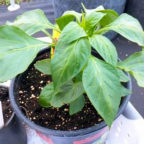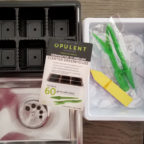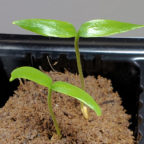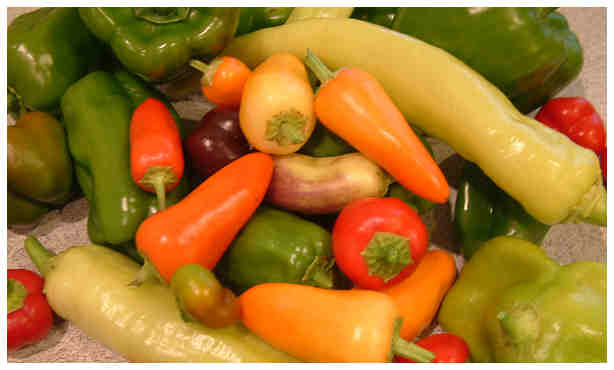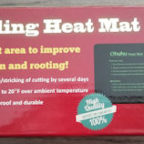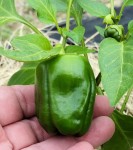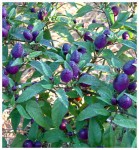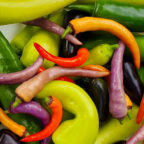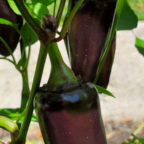Growing Peppers From Seeds, Part 2
I got a little carried away describing some different pepper seeds for different climates in my previous growing peppers from seeds post. So now let’s talk about the actual planting process.
What You Need
You’ll need the following to plant your pepper seeds. I germinate mine indoors, and then transplant them a little later. So here’s how to plant the seeds indoors, followed by directions for sowing seeds directly outdoors.
For indoors you will need:
- 3-ounce Dixie cups or windowsill seed starter tray.
- Spoon.
- Waterproof container to hold the cups (not needed if you are using the seed starter tray).
- Seed-starting soil or peat cylinders (comes with the seed starter tray).
- Hand sprayer that sprays a very fine mist of water.
- Scissors (if using Dixie cups).
- Seed packet(s).
Optional
- Labels to mark the pepper variety, plus a marker with waterproof ink.
Getting the Containers Ready
First, get the container(s) (Dixie cups or seed starter tray) ready with the soil, then dampen the soil. If you are using the Dixie cups, use the scissors to cut 4 small holes towards the bottom of the cups, for drainage. If you are using the seed starter tray, soak the peat cylinders in water according to the directions.
I like to use a small spoon to get the seed-starting soil into the Dixie cups.
If you are planting several varieties of seeds (which is what I like to do), you may want to label your containers with the varieties. You can use the waterproof markers and labels for the Dixie cups, or sketch a simple diagram of the windowsill seed starter tray.
Planting the Pepper Seeds
Once the soil or cylinders are damp. place the seeds in the cups/cylinders. I tend to plant 3 seeds in each Dixie cup, thinning to the strongest if they all germinate. Follow the directions as to number of seeds for the seed starting tray.
For the Dixie cups, you then want to place a fine layer of soil over the seeds. Don’t make it too deep, or the seeds will lose their strength just trying to get above ground.
When you are done planting, spray a fine mist of water over the soil. If you’re using the Dixie cups, put them in a waterproof container.
Then put some water at the bottom of the seed starter tray or the waterprood container. You want to water from below, to encourage the tiny plants to grow their roots deep instead of shallow. But be careful not to drown them! You want the soil damp, not wet.
You’re done! Now put the tray or container in a spot where it will be warm. When the seeds start to germinate, move them to somwhere where they will get plenty of indirect sun, or under grow lights.
Growing Peppers by Sowing Outside
It’s actually fairly simple to sow directly outside, but you must wait until all danger of frost is past, and the soil needs to be at least 60 degrees warm. Pick a sunny spot where the pepper plants will get plenty of sun.
Your biggest job will be preparing the soil outside. You want it loose enough so that the peppers can poke their heads above soil easily, but with enough nutrients to keep them going.
When I planted my peppers outside, I put plenty of compost and cow manure into the soil, then thoroughly mixed it to a depth of 6 inches. Depending on your soil, you may or may not need a tiller to help you with this. Dampen the soil when you are done; you want it moist, not wet.
Once your soil is prepared, plant your seeds about 18 inches apart. I like to plant three seeds in each set, then thin to the strongest one.
Cover the seeds with a fine layer of seed-starting soil, which makes it easier for the young plants to poke their heads above ground once they germinate. Mist with a sprayer until the soil is damp over the seeds.
And Now the Hard Part
The hardest part is waiting for the seeds to germinate. I’ve had them take as few as 5 days to as long as 3 weeks, and different varieties take different lengths of time to germinate. Just be patient and keep the soil moist.
There you go — planting your pepper seeds! If you’d like more detail on planting seeds of any kind, one book I like a lot is The New Seed Starter’s Handbook. Very detailed, you’ll be growing your own garden from seed in no time!
Growing Peppers From Seeds
Growing peppers from seeds isn’t as hard as you might think. The absolute hardest part is waiting for the seeds to germinate and poke their little heads above ground! (Well, that’s the hardest part for me, at any rate.) 🙂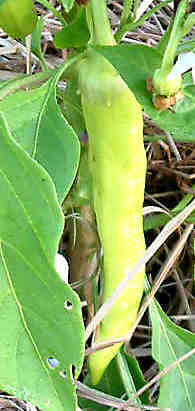
So let’s take a look at what needs to happen in order to grow pepper plants from seeds.
Pick Your Pepper (Seeds)
First is to consider your climate, and where you plan to grow your pepper plants. Pepper plants love sunlight and warmth, so if you live in the Pacific Northwest, you’re a bit more challenged than someone who lives in the desert Southwest or Deep South.
If you live in a cooler climate, pick plants that produce peppers early in the season. It will take longer for the peppers to grow and mature, so an early season pepper is best. For sweet peppers, you may want to take a look at sweet banana peppers. These peppers are prolific and bear pretty early.
(Note: You don’t have to live in the Pacific Northwest to enjoy this pepper — you can grow it about anywhere.)
One further note about the Pacific Northwest climate is that hot chile peppers won’t get as hot where you live, compared to if you grew them in a warmer climate. Not sure why that happens, but be aware of it. Of course, deppending on the variety, they can be pretty hot anyway!
OK, say you live in a moderate climate; congratulations, you can grow about anything! If you have a fairly short Summer, you may want to stick with the earlier varieties (less than 60 days from transplant). But if you have a longer Summer, take your pick! One early-to-mid season bell which ripend to red that I like is called
Keystone bell pepper.
If you’re looking for a neat hot chili pepper to grow that produces and produces and then produces some more, think about Jalapeno M.
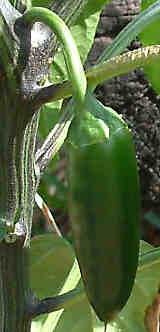 Every time I have grown jalapenos, the plants have produced beyond expectations. I’ve always had plenty to eat, and plenty to share with family, friends and neighbors. In fact, one plant (planted in the garden in a large hole filled with compost) had so many peppers I almost considered selling them (the peppers, that is). It grew huge and was covered with jalapenos.
Every time I have grown jalapenos, the plants have produced beyond expectations. I’ve always had plenty to eat, and plenty to share with family, friends and neighbors. In fact, one plant (planted in the garden in a large hole filled with compost) had so many peppers I almost considered selling them (the peppers, that is). It grew huge and was covered with jalapenos.
OK, so most of my jalapeno plants didn’t go to quite those lengths, but each one has produced plenty of peppers for eating and sharing.
OK, you’re in the really southern climates with long summers and mild winters. You can grow just about anything as well, but hot chile peppers in particular love the climate. Of course, being a hot, hot, hot pepper lover, I choose habaneros and scotch bonnets. A nice one is Hot Paper Lantern habanero.
A word of warning for those of you who live in super-hot climates with strong summer sun — think about growing your peppers in dappled shade, or so they don’t get full sun from about noon to three. Living in South Florida, my summertime peppers do much better if they aren’t in full sun during the hottest part of the day.
And if anyone wants to check out more pepper seeds, take a look at this link for all kinds of pepper seeds.
To Be Continued…
This post has gotten longer than I had planned, so here’s part two of growing peppers from seeds, with the actual planting instructions.
About Chile Peppers
Chile, chili, hot — what’s the difference? None, really. These pungent peppers are often called by any of the above names.Â
Chile peppers are members of the genus Capsicum, and they are unrelated to black peppercorns (part of the Piper family). For convenience, however, we’ll only use the term “chile” when referring to these peppers. Please note, however, that there are several varieties that are actually have the word “chile” in their name.
Chile Pepper Facts
Where Did Peppers Come From? The hot chile pepper is a New World addition to the diet, discovered by none other than Christopher Columbus on his first voyage in 1492. Today, we know of more than 200 varieties, over 100 of which are indigenous to Mexico.
Are Peppers Good for You? Fresh chile peppers are loaded with Vitamin C — twice as much as citrus fruits! Fresh chiles also contain Vitamin A. What about dried? Well, drying chiles destroys most of the Vitamin C, but increases the Vitamin A content — up to 100 times! Some weight-loss programs advocate the use of spicy foods (chiles included), saying that the heat generated by the spice revs up the metabolism.
How Hot is “Hot”? Back in 1902, a scientist by the name of Wilbur Scoville devised a test to measure the relative heat of the chile peppers. This resulting scale is referred to as the “Scoville Scale”. For example, bell peppers register a “0-100” on the Scoville, while the mighty habanero registers a whopping “300,000+”. That’s hot!
Here’s a list of commonly eaten peppers, with their Scoville rating (from mildest to hottest):
- Bell peppers with a rating of 0-100
- Anahaeim peppers with a rating of 500-3,500
- Ancho/Poblano peppers with a rating of 500-1,000
- Pasilla peppers with a rating of 1,000-3,000
- Numex/New Mexico peppers with a rating of 3,000-4,000
- Hungarian peppers with a rating of 3,500-4,500
- Jalapeno peppers with a rating of 5,000-7,000
- Serrano peppers with a rating of 6,000-10,000
- De Arbol peppers with a rating of 15,000-30,000
- Cayenne peppers with a rating of 30,000-50,000
- Chipotle/Morita peppers with a rating of 75,000
- Chiltepin/Birdseye peppers with a rating of 50,000-100,000
- Scotch Bonnet peppers with a rating of 200,000
- Habanero peppers with a rating of 300,000+
- Habanero “Red Savina” with a rating of around 500,000
- Jolokia is now the official hottest, with a rating of over 1,000,000!
Now these numbers aren’t chisled in stone; for example, there are jalapenos that have practically no heat, as well as some that are extra hot. Different varieties of the same pepper can have different Scoville ratings. Add to that is this little fact; the hotter the climate where the pepper is grown, the higher the Scoville rating.
What Makes Chiles so Hot? A substance called capsaicin is what makes the chiles to hot! The more capsaicin, the hotter it is. Pure capsaicin tops out the Scoville scale with a rating of 16,000,000!
Too Hot! How Can I Cool my Mouth? First of all, do not drink beer, water or a carbonated beverage — it will just make things worse! Capsaicin is an oil, and these liquids just spread it around. Try drinking milk, or eating some sour cream (or ice cream). Dairy items neutralize the oil and cool the burn.
Can I Lower the Heat of a Pepper? Sure! If you want to reduce the flames (so to speak), you can “neuter” the pepper by paring away the interior ribs and removing the seeds. If the pepper is a really hot one, you might not notice a great difference, though.
How Can I Determine the Heat of an Unfamiliar Pepper? Assuming that you don’t want to taste-test the pepper, here’s a general rule-of-thumb — the bigger the pepper, the lower the heat. The reverse is generally true as well — the smaller the pepper, the hotter it is.
Where Can I Get Chiles? Chiles are increasingly available in grocery stores, but why not grow your own? They’re fun to grow, and you can be sure they’re fresh. Also, growing your own chile peppers allows you to grow the varieties that you like — not what the grocery store buyer thinks you should like.
How Long Will a Pepper Plant Live? This all depends on the species of pepper plant. There are three main cultivated species: Capsicum annuum, Capsicum frutescens, and Capsicum chinense. Most peppers grown are of the Capsicum annuum species, and so are annual plants (living only one year). The Tabasco pepper (Capsicum frutescens) also lives a similar time. On the other hand, Capsicum chinense, otherwise known as the Habanero or Scotch Bonnet, is a perennial in a semi-tropical or tropical environment. In addition, the Capsicum baccatum, of which Ajis are a member, can also occasionally live more than one season.
